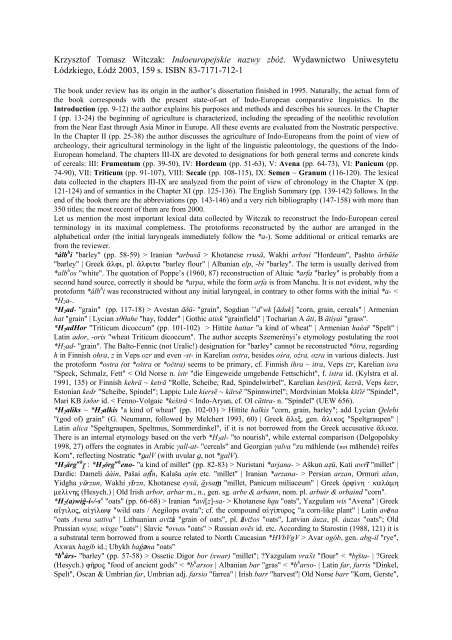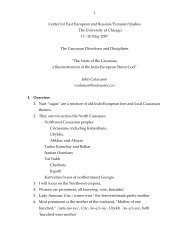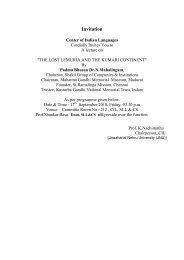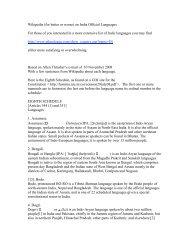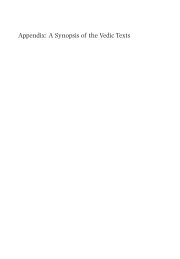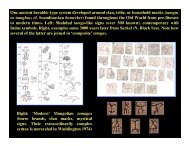Krzysztof Tomasz Witczak: Indoeuropejskie nazwy zbóż ...
Krzysztof Tomasz Witczak: Indoeuropejskie nazwy zbóż ...
Krzysztof Tomasz Witczak: Indoeuropejskie nazwy zbóż ...
You also want an ePaper? Increase the reach of your titles
YUMPU automatically turns print PDFs into web optimized ePapers that Google loves.
<strong>Krzysztof</strong> <strong>Tomasz</strong> <strong>Witczak</strong>: <strong>Indoeuropejskie</strong> <strong>nazwy</strong> <strong>zbóż</strong>. Wydawnictwo Uniwesytetu<br />
Łódzkiego, Łódż 2003, 159 s. ISBN 83-7171-712-1<br />
The book under review has its origin in the author’s dissertation finished in 1995. Naturally, the actual form of<br />
the book corresponds with the present state-of-art of Indo-European comparative linguistics. In the<br />
Introduction (pp. 9-12) the author explains his purposes and methods and describes his sources. In the Chapter<br />
I (pp. 13-24) the beginning of agriculture is characterized, including the spreading of the neolithic revolution<br />
from the Near East through Asia Minor in Europe. All these events are evaluated from the Nostratic perspective.<br />
In the Chapter II (pp. 25-38) the author discusses the agriculture of Indo-Europeans from the point of view of<br />
archeology, their agricultural terminology in the light of the linguistic paleontology, the questions of the Indo-<br />
European homeland. The chapters III-IX are devoted to designations for both general terms and concrete kinds<br />
of cereals: III: Frumentum (pp. 39-50), IV: Hordeum (pp. 51-63), V: Avena (pp. 64-73), VI: Panicum (pp.<br />
74-90), VII: Triticum (pp. 91-107), VIII: Secale (pp. 108-115), IX: Semen ~ Granum (116-120). The lexical<br />
data collected in the chapters III-IX are analyzed from the point of view of chronology in the Chapter X (pp.<br />
121-124) and of semantics in the Chapter XI (pp. 125-136). The English Summary (pp. 139-142) follows. In the<br />
end of the book there are the abbreviations (pp. 143-146) and a very rich bibliography (147-158) with more than<br />
350 titles; the most recent of them are from 2000.<br />
Let us mention the most important lexical data collected by <strong>Witczak</strong> to reconstruct the Indo-European cereal<br />
terminology in its maximal completness. The protoforms reconstructed by the author are arranged in the<br />
alphabetical order (the initial laryngeals immediately follow the *a-). Some additional or critical remarks are<br />
from the reviewer.<br />
*álb h i "barley" (pp. 58-59) > Iranian *arbusā > Khotanese rrusX, Wakhi arbəsi "Hordeum", Pashto ōrbūše<br />
"barley" | Greek ¥lfi, pl. ¥lfita "barley flour" | Albanian elp, -bi "barley". The term is usually derived from<br />
*alb h os "white". The quotation of Poppe’s (1960, 87) reconstruction of Altaic *arfa "barley" is probably from a<br />
second hand source, correctly it should be *arpa, while the form arfa is from Manchu. It is not evident, why the<br />
protoform *álb h i was reconstructed without any initial laryngeal, in contrary to other forms with the initial *a- <<br />
*H2a-.<br />
*H2ad- "grain" (pp. 117-18) > Avestan Xδū- "grain", Sogdian ’’d’wk [Xduk] "corn, grain, cereals" | Armenian<br />
hat "grain" | Lycian xθθahe "hay, fodder" | Gothic atisk "grainfield" | Tocharian A āti, B ātiyai "grass".<br />
*H2adHor "Triticum dicoccum" (pp. 101-102) > Hittite hattar "a kind of wheat" | Armenian haèa> "Spelt" |<br />
Latin ador, -oris "wheat Triticum dicoccum". The author accepts Szemerényi’s etymology postulating the root<br />
*H2ad- "grain". The Balto-Fennic (not Uralic!) designation for "barley" cannot be reconstructed *ōtra, regarding<br />
h in Finnish ohra, z in Veps ozr and even -st- in Karelian ostra, besides ośra, oźra, ozra in various dialects. Just<br />
the protoform *ostra (or *oštra or *očtra) seems to be primary, cf. Finnish ihra ~ itra, Veps izr, Karelian isra<br />
"Speck, Schmalz, Fett" < Old Norse n. ístr "die Eingeweide umgebende Fettschicht", f. ístra id. (Kylstra et al.<br />
1991, 135) or Finnish kehrä ~ keträ "Rolle, Scheibe; Rad, Spindelwirbel", Karelian kes(t)rä, kezrä, Veps kezr,<br />
Estonian kedr "Scheibe, Spindel"; Lappic Lule kiersē ~ kärsē "Spinnwirtel"; Mordvinian Mokša kšťiŕ "Spindel",<br />
Mari KB šəδər id. < Fenno-Volgaic *kešträ < Indo-Aryan, cf. OI cāttra- n. "Spindel" (UEW 656).<br />
*H2aliks ~ *H2alkis "a kind of wheat" (pp. 102-03) > Hittite halkis "corn, grain, barley"; add Lycian Qelehi<br />
"(god of) grain" (G. Neumann, followed by Melchert 1993, 60) | Greek ¥lix, gen. ¥likoj "Speltgraupen" |<br />
Latin alica "Speltgraupen, Speltmus, Sommerdinkel", if it is not borrowed from the Greek accusative ¥lika.<br />
There is an internal etymology based on the verb *H2al- "to nourish", while external comparison (Dolgopolsky<br />
1998, 27) offers the cognates in Arabic γall-at- "cereals" and Georgian ¦alva "zu mählende (not mähende) reifes<br />
Korn", reflecting Nostratic *—alV (with uvular —, not *galV).<br />
*H2árg wh 3 : *H2órg wh eno- "a kind of millet" (pp. 82-83) > Nuristani *arjana- > Aškun a¬ü, Kati awŕÉ "millet" |<br />
Dardic: Dameli äàin, Pašai a0ïn, Kalaša a0in etc. "millet" | Iranian *arzana- > Persian arzan, Ormuri ažan,<br />
Yidgha y¨rzun, Wakhi yírzn, Khotanese eysä, āysaf "millet, Panicum miliaceum" | Greek Ñrf…nh : kal£mh<br />
mel…nhj (Hesych.) | Old Irish arbor, arbar m., n., gen. sg. arbe & arbann, nom. pl. arbuir & orbaind "corn".<br />
*H2(a)wiĝ-i-/-s o "oats" (pp. 66-68) > Iranian *avi[z]-sa- > Khotanese h6u "oats", Yazgulam wis "Avena" | Greek<br />
a‡giloj, a„g…lwy "wild oats / Aegilops ovata"; cf. the compound a„g…puroj "a corn-like plant" | Latin av¯na<br />
"oats Avena sativa" | Lithuanian aviž" "grain of oats", pl. +vižos "oats", Latvian àuza, pl. àuzas "oats"; Old<br />
Prussian wyse, wisge "oats" | Slavic *ovьsь "oats" > Russian ovës id. etc. According to Starostin (1988, 121) it is<br />
a substratal term borrowed from a source related to North Caucasian *HVbVgV > Avar ogób, gen. abg-il "rye",<br />
Axwax hagib id.; Ubykh ba‘‰na "oats"<br />
*b h árs- "barley" (pp. 57-58) > Ossetic Digor bor (xwar) "millet"; ?Yazgulam vraЋt "flour" < *b3šta- | ?Greek<br />
(Hesych.) fÁroj "food of ancient gods" < *b h arsos | Albanian bar "gras" < *b h arso- | Latin far, farris "Dinkel,<br />
Spelt", Oscan & Umbrian far, Umbrian adj. farsio "farrea" | Irish barr "harvest"| Old Norse barr "Korn, Gerste",
Old English bere "barley"; cf. the derivatives *b h ars(e)ino- > Latin farīna "flour" | Gothic barizeins "of barley",<br />
Old English beren id. | Slavic *boršьno > Old Church Slavonic brašīno "food", Russian bórošno "flour of rye";<br />
and *b h arsagen- > Old Irish bairgen "bread", Welsh, Cornish, Breton bara id. | Latin farrāgō, -inis<br />
"Mengfutter". The author quotes Semitic *burr-/*barr- "grain, wheat" as cognate, in contrary to Illiè-Svityè<br />
(1964, 4-5) or Gamkrelidze & Ivanov (1984, 872, 943) who saw in the Semitic term a source of the Indo-<br />
European forms.<br />
*b h 3sdaH2 "Triticum monococcum" (pp. 97-98) > Albanian bardhë "wheat" | Thracian br…za "a kind of corn,<br />
perhaps wheat or rye" | Germanic *bursta- > Old High German borse, Middle high German porst "Myrica gale",<br />
German Sumpf-porst "Ledum palustre" | Lithuanian bi9zdis, birždis, brizdis "heather, Calluna vulgaris". The<br />
termination in *-sd- is common with *’ h ersd- "barley".<br />
*d3wHaH2 "a kind of millet" (pp. 83-84) > OI dªrvā- "sp. millet, Panicum dactylon" | Gallo-Latin dravoca<br />
"Personacia, lappa", Welsh drewg, Breton draoch, dreok "Lolium termulentum" > French droue id. | Middle<br />
Dutch tar(e)we, Dutch tarwe "wheat", Middle English tāre "Lolch, Wicke", English tare id. < *dorəwW |<br />
Lithuanian dirv" "Saatfeld, Getreidefeld", Latvian dirva, druva "der bestellte Acker, Saatfeld" | Russian derevki<br />
"place in a forest cleared for agriculture", dérevnja "Dorf", pášet derévnju "bestellt das Feld". Traditionally<br />
Thessalian d£ratoj, Delphian dar£ta, Macedonian dr£mij "bread" have been added too. <strong>Witczak</strong> also<br />
speculates about a connection with some Semitic forms as Ugaritic drt pl. "millet" and Arabic durrat "grobe<br />
Hirse, Maise". But IE *d does not correspond with Semitic *d in a frame of the Nostratic hypothesis. This<br />
relation can be interpreted only as a Semitic borrowing in Indo-European.<br />
*d h oHnáH2 f. "corn" (pp. 39-41) > OI dhānZ "corn, grain" | Khowar dān "parched grain" | Avestan dānōkarš(a)-<br />
"körnerschleppend", Khotanese dāna- "grain, corn", Sogdian δ’n "Getreidekorn" | ?Hittite NINDA dannas<br />
"eine Speise", Luwian tannas | Lithuanian dúona "bread", Latvian duõna "crust or slice of bread" ||| Semitic<br />
*du¯n-u "Sorghum vulgare" ||| Dravidian *tin-ay "Italian millet" < Nostratic **dEqnV.<br />
*gand- ~ *skand- "a kind of wheat" (pp. 96-97) > OI gōdhūma- "wheat" | Iranian *gantuma- id. > Avestan<br />
gaztuma-, Sogdian gantum vs. *ganduma- > Khotanese ganag, Pašto γanəm, Munjan γandám | ?Hittite kant-<br />
"wheat"? (if it does not derived from IE *k‚t- "rye") | Latin scandala & scandula "Spelt, Triticum spelta".<br />
Witzcak’s comparison with Semitic *int-(at-) "wheat" is excluded, because according to the Nostratic<br />
hypothesis, Semitic * does not correspond with any Indo-European velar in the initial position.<br />
*’3Hnom "grain" > corn" (pp. 44; 116-17) > Pashto zəzay "grain" | ?Albanian Gheg grûnë "wheat, corn"| Latin<br />
grānum "grain"| Old Irish grán "grain", Welsh grawn | Gothic kaurn, Old English corn, Old High German, Old<br />
Norse korn "grain" | Lithuanian žirnis, Latvian zi9nis "pea", Old Prussian syrne "kernel of fruit" | Old Church<br />
Slavonic zrьno, Russian zernó etc. The traditional etymology derives it from the verb *ĝerH2- "aufreiben, alt<br />
machen" (LIV 165-66).<br />
*g h rudom "grain" (p. 119) > ?Albanian Gheg grûnë "grain, wheat" < *gr³dino- (but cf. the preceding entry) |<br />
Old English grūt "grout", Old High German gruzzi "Grütze" < *grutjō | Lithuanian grdas "grain" (the length<br />
after Winter’s law?), Latvian gruds id. Derived from the verb *g h rud- "to beat" > Lithuanian grªsti : grªdų.<br />
*’ h érsd (h) - : *’ h rôd h - "barley" (pp. 55-57) > ?Middle Persian Æurtāk & zurtāk "corn", Persian zurt & zurd "a kind<br />
of millet", dial. Æurdā "corn" | Greek kr‰ n., gen. kr‹qoj "barley", f. kriq» id. = Mycenaean ki-ri-ta | Albanian<br />
drith m. & drithë n. "corn" | Latin hordeum "barley"| Germanic *gerstō > Old High German gersta "barley",<br />
Dutch gierst "millet"; while Old English gorst "Brombeerstrauch, Stechginster" reflects Germanic *gursta-.<br />
*kaskos "barley" (p. 57) > Iranian *kaska- > Khotanese chaska- "corn", Munjan kosk "Hordeum", Šughni čūšč,<br />
Rušani čošč "barley" etc., Persian kašk id. | ?Armenian hask "ear of corn". The correspondence of Armenian h-<br />
vs. Iranian *k- is rather problematic. On the other hand, there is an alternative etymology for the Iranian forms,<br />
starting from the reconstruction *k3ša-ka- (Pachalina 1983, 115), namely its comparison with Slavic *kolsъ "ear<br />
of corn" | Albanian kallë "id.; stalk" | Tocharian B klese "a kind of food or an ingredient necessary for baking<br />
kanti-bread"; the unattested Tocharian A counterpart could be identified in the Old Chinese loan *klas "grain"<br />
(Blažek 1999, 79-80).<br />
*k‚t- "rye or a similar cereal" (pp. 111-112) > Hittite Hittite kanta-, Luwian kant- "Einkorn; Triticum<br />
monococcum" | Dacian kot…ata "Triticum repens" | ?Lusitanian > Latin centēnum "rye, Secale" (first in the<br />
Edict of Diocletian from AD 301), continuing in the Ibero-Romance languages: Spanish centeno, Portugal<br />
centeio | Tocharian B kanti "a kind of bread or a baked product made of flour". <strong>Witczak</strong> also thinks about a<br />
relation of Fenno-Permian *knt® "Getreide, Same" (cf. Blažek 2003, 92-93).<br />
*$ers- "millet" (p. 82) > Hittite karas- n., karsas- "wheat Triticum dicoccum or Triticum durum" | Oscan caria<br />
"bread", Sabine ceres n. id., cf. Latin Ceres, -eris ‘goddess of fertility’ | Germanic *hersja- m. "Hirse" > Old<br />
High German hirso, hirsi, Old Saxon hirsi id. It is generally accepted to derive this phytonym from the verb<br />
*$erH3- "to nourish" (cf. LIV 329), not *$er-. This etymology represents the only evidence for the<br />
reconstruction of the initial *$-. It is tempting to add some of the Dardic designations of "millet": Kalaša karas,
Khowar khərāš, Phalura kāraž, Dameli kZraJ id. (Steblin-Kamenskij 1982, 46). The acceptance of their<br />
relationship implies the reconstruction of velar *k-.<br />
*$op[-3] "oats" (pp. 68-69) > OI śāpa- m. "treibholz, Trift, Geflötes", m. "angeschwemmtes Schilf" | Alan zabar<br />
"auena"; Šughni sip(i)yak "a kind of millet" (Iranian *sāpar-ku-), Persian sabz "vegetable; grass" (Iranian *s`pač÷-),<br />
Rošani sabēc "pod of bean" (Iranian *sāpaitra- = OI śāpera-) | Hittite kappara- "vegetable" | Greek<br />
kÒphqron "a wild vegetable" (Hesych.) | Middle Irish corca, coirce "oats"; Welsh ceirch, Cornish kerch, keirch,<br />
Middle Breton querch, Breton cerc’h < Celtic *kor(i)kkyo- < *kop3-kyo- | Old Norse hafri m. "oats", English<br />
dial. haver, Old Saxon haboro, Old High German habaro "Hafer" < Germanic *habrōn || Lithuanian šãpas<br />
"Halm, Ästchen, Splitter".<br />
*$þoryanos "a kind of wheat" (pp. 99-100) > Armenian c‘orean "wheat Triticum carthlicum" | Middle Irish<br />
tuirenn, Irish tuirend f. "wheat". <strong>Witczak</strong> speculates about a relation with Kartwelian *di"a- "wheat", assuming<br />
the correspondence of the IE cluster *$þ- to the sequence *di" o in Kartwelian.<br />
*k w oidyos "wheat" (pp. 98-99) > Germanic *hwaitja- "wheat" > Gothic ¹aiteis, Old Norse hveiti, Old English<br />
hwdte, Old High German weizzi | Old Prussian gaydis m. & gayde, gaide f. "wheat" with g- instead of expected<br />
k-, analogously to girmis "worm" vs. Lithuanian kirmis id. < *k w 3mis. The author does not explain his rejection<br />
of the etymology based on Germanic *hwaita- "white".<br />
*melH-i, o n-és "Italian millet" (pp. 77-78) > Khowar blan "sp. barley" (after Turner compatible with Sanskrit<br />
mlāna- "withered, shrivelled, dark-coloured" | Greek mel…nh "Kolbenhirse" | Latin milium "Hirse, Rispenhirse" |<br />
?Old Norse melr "Elymus sabulosus" | Lithuanian málna "Schwaden, Sussgras, Kolbenhirse". <strong>Witczak</strong> discusses<br />
three etymologies: 1) IE *melH- "to grind, mill"; 2) *melH2-n- "black", cf. OI śyāmZka- "Indian millet / Panicum<br />
frumentaceum" : śyāmá- and the semantically opposite counterpart in IE *alb h -i "barley", regarding the moste<br />
probable derivation from IE *alb h o- "white"; 3) IE *mél-i-t, gen. *mel-n-és "honey". Outside of Indo-European,<br />
<strong>Witczak</strong> quotes Furnée’s interesting parallel in Georgian meleuli & meleuri "zu Gaben gebundene Hirse", which<br />
may be interpreted as the collective from the unattested protoform *meli "Hirse", following the model of<br />
p‘ureuli "Getreidearten, Könerfruchte" vs. p‘uri "Brot, Korn, Getreide".<br />
*p3Hwen- "a kind of wheat" (p. 103) > Hittite parhuenas "eine Art Getreide" | Gallo-Latin arinca "wheat<br />
Triticum dicoccum" < pre-Celtic *[p]arwenkā.<br />
*pro$om "common millet" (p. 81) > Old Prussian prassan "millet" | Slavic *proso id. <strong>Witczak</strong> proposes an<br />
interesting idea to see here a metathetical variant of *$op3 "oats". Recently Ivanov (2003, 196-97) has found a<br />
more exact cognate in Tocharian B proksa "grain", deriving them from *pro$s- and further from the root *per$-<br />
"to dig", cf. West IE *p3$-ā "furrow".<br />
*pūrós, -óm "Triticum compactum" (pp. 94) > OI p¨ra- m. "cake" | Greek pūrÒj "Weizen(korn), Triticum<br />
compactum" | ?Germanic fursa- > Old English fyrs, English furze "Quecke, Triticum repens" | Lithuanian m. pl.<br />
pūraĩ "Winterweizen", Latvian m. pl. pû7i id., Old Prussian f. pure "Trespe, Bromus secalinus" | Chrch Slavonic<br />
pyro "Spelt", Slovenian m. pîr, f. píra "Spelt", Czech pýr "Quecke, Triticum repens", Russian pyréj id. <strong>Witczak</strong><br />
mentions that the Germanic example better agrees in phonetics with Greek pr£son "Allium porrum", Latin<br />
porrum id. < *p4som. Traditionally, Georgian p‘uri "wheat, wheat, corn" has be compared too, although its<br />
Greek origin cannot be excluded.<br />
*putro- "grain, corn" (pp. 119-20) > Welsh wtr "light corn; light grain" < *putro- | Lithuanian putrà "Grütze",<br />
Latvian putra id.; Baltic > Finnish puuro "porridge".<br />
*rug h is, *rug h yos "rye" (pp. 110) > Iranian *ruÆika- > Šughni ro¢z "ear of rye or rice", Wanetsi rō¢j "ear of<br />
corn" (> Mordvinian roź; Komi ruďźeg, Udmurt dial. ieg "rye"; see Blažek 2003, 93-94) | Germanic *rugiz ><br />
Old Norse rugr "rye", Old English ryge id. & *ruggan- > Old Frisian rogga, Old Saxon roggo, Old High<br />
German rocko id.| Lithuanian rugÓs "Roggenkorn", Old Prussian rugis, ruggis m. "rye" | Old Russian rъžь m.<br />
"rye". <strong>Witczak</strong> adds the Afroasiatic parallels: Egyptian rdrd "cereals" and Hausa roogo "cassawa" which seem<br />
more convincing than the comparison with East Caucasian *rəGGV "a kind of cereal (oats, rye), because later this<br />
reconstruction looks otherwise (Nikolajev & Starostin 1994, 950: *rħə\V ~ *\ħərV > Avar ro\\ "wheat";<br />
Lezgin gerg "oats", Agul jerg, Tabasaran, Tsakhur γarγar id.).<br />
*séH1m‚ "grain" (p. 118) > Latin sēmen "seed" | Old Saxon sāmo, Old High German samo "Same" | Old<br />
Prussian semen "Samen", Lithuanian sjmenys pl. "Flachsaat" | Old Church Slavonic sěmę "seed, semence".<br />
*seH1tlaH2 "seed" > Albanian gjollë "seed-patch" | Old Irish síl "seed"; Welsh hil "Samen, Nachkommenschaft"<br />
< Celtic *sēllo-| Lithuanian sėklà "Saat". But there is no unambiguous evidence about the tl-extension. The<br />
Albanian and Celtic examples can reflect *sēlo-/-ā. In Lithuanian paselÓs "Aussaat" there is the only l-extension,<br />
similarly in Hittite sēli- "Getreide(haufen)" (Oettinger 1979, 541).<br />
*s e syW f., *s e syóm n. "corn" (pp. 41-42) > OI sasyám n. "Feldfrucht, Saat auf dem Felde", sasá- m. "Nahrung,<br />
Speise, Kraut, Gras, Saatfeld" | Avestan hahiia- "frumentarius", haŋhuš- | Hittite sesa- "Frucht" | Celtic *sasio-<br />
& *sasiā > Hispano-Celtic *sas(s)ia > Provençal saisseto "froment de la plus belle qualitè", Catalonian xeixa<br />
"candeal", Spanish jeja "Winterweizen"; Gaulish asia "rye"; Welsh haidd "barley", Breton heiz id. Let us
mention Starostin’s idea (1988, 125) about a substratal origin of this term, based on his comparison with Eastern<br />
Caucasian *sūsV "rye" > Čečen sos, Laq sus id., Axwax šušul "oats" etc.<br />
*sīto-, *sītyo- "corn" (pp. 45) > OI sôt(i)yam n. "corn" (lex.), besides a more frequent meaning "ploughed"<br />
attested by Pāzini | Khowar [not Kati indicated by author] siri "barley", Kalasha šilô "millet" | Mycenaean si-to<br />
"corn; grain (of wheat of barley)", Greek s‹toj "Getreide", especially "Weizen, Brot, Speise", Delphian s‰ton.<br />
According to <strong>Witczak</strong> the preserved s- could be caused by its hypothetical Pelasgian origin.<br />
*spérm‚ : *sporáH2 (p. 119) > Armenian sermn "seed; grain" | Greek spšrma "Same" = Mycenaean pe-mo,<br />
spor£ "Säen, Saat" | Albanian farë "seed; clan" (spórā). Derived from the verb *sper- (LIV 580) attested e.g. in<br />
Armenian sermanel "to sow", Greek spe…rw "to sow; produce, beget, give birth".<br />
*(s)pCt- "Triticum spelta" (pp. 100) > Greek pÒltoj "Brei aus Mehl" | Latin puls, pultis f. "eine Spelzgrütze",<br />
Old Italian polta "Brühe, Brei" > Old High German polz id.; late Latin spelta occurs first in the edict of<br />
Diocletian AD 301; according to witness of Saint Hieronym it is of Pannonian origin.<br />
*swaH2raH2 "common millet" (pp. 79-81) > Iranian hwārā- > Alan huvar "millet", Ossetic Digor xwar "corn,<br />
grain, millet", Iron xor "corn, barley Hordeum vulgare", Sogdian γwr- "barley", Middle Persian xwār "food" |<br />
?Albanian egjër "Lolium termulentum" < *‚-s(w)ārā = "non-millet" after Jokl (Wörter und Sachen 12, 1929,<br />
78-79) | Lithuanian sóra, pl. sóros "millet", Latvian sâre, dial. sûra "Rispenhirse" | Tocharian AB sāry- "to<br />
plant", sārm "seed"; the n-derivative is common for Iranian and Baltic: Avestan x v arəna-(not xv v arəna-)<br />
"Nahrung"; cf. the borrowing in Slavic *chorna "food" | Lithuanian svirna f., svi9nas m. "Speicher,<br />
Vorratskammer". The author admits the v3ddhi-formation from the root *swer- > Iranian *x v ar- "to nourish;<br />
defend". But he prefers the Nostratic origin, referring to such forms as Semitic *fu C ār-(at-) "barley" (lit. "hairy")<br />
and Uralic *śōra.<br />
*wesH2aros "spring corn" (pp. 42-43) > Armenian gari, gen. gareoy "barley" | Welsh wenith, Breton gwiniz<br />
"wheat" | Tocharian A wsār "heap of grain", B ysāre "grain; ?wheat"; from the word for "spring" reconstructible<br />
as *wesH3, gen. *wesH2nos, cf. Lithuanian vasar¿niai kviečiaĩ & rugiaĩ "spring wheat & rye", etc.<br />
*yéwH1os, -om "barley" > "corn" (pp. 43-44) > OI yáva- m. "barley" | Avestan yauua- m. "Getreide", yauua—ha-<br />
n. "Weide"; Ossetic yäw "millet" | Hittite ewan n. "barley" | Greek zeia… "Triticum monococcum", Cretan dha…<br />
"barley; Hordeum" | Old Irish éorna "barley" | Lithuanian jãvas "Getreideart", pl. javaĩ "Getreide" | Earlier<br />
Russian jevin, Russian ovin "Getreidedarre, Riege" | Tocharian B yap "millet" < *yewH1om.<br />
Comments to the additional comparative material:<br />
P. 46 - Slavic *žito "corn, cereal", especially "wheat, rye" | Old Prussian geits & geitko "bread" | Welsh bwyd<br />
"food", Old Cornish buit, Breton boed; Old Irish biad. Add Hittite kuuitta- "a kind of a bread" (Van Windekens,<br />
Archiv orientální 57, 1989, 334-35; Puhvel, HED IV, 1997, 315).<br />
P. 59 - Slavic *ęčь-my "barley" - following Charpentier (1907, 464), it is possible to connect it with Greek<br />
Ômp(n)h "Nahrung, Getreide". Starostin (1988, 127) proposed a substratal origin of *Henk w -/*Honk w -, seeking a<br />
support in North Caucasian *#əIm%%wV "barley", reconstructed on the basis of Avar o%, Bežit õX id., Axwax<br />
ũqa "oats", Ubykh Xwa "barley", etc. But later Nikolajev & Starostin (1994, 502-503) changed their<br />
reconstruction in *ħn\rqwÌ, regarding Tabasaran nurχI "spelt", Agul nir`X "ground wheat".<br />
P. 63 - Tocharian klu "rice" is derivable from an Old Chinese source of the type *lhū’ ~ *łhū’ "growing rice,<br />
paddy" (Blažek 1999, 82).<br />
P. 106 - Old High German dinchel, thincil, dinkil "Dinkel, Triticum spelta", with the variants tünkel, tunkel from<br />
modern dialects, is compatible with Anatolian data: Hittite (NINDA) tuni(n)k- "a bread", Hieroglyphic Luwian<br />
tunikala "maker of tunik-bread", with the suffix -ala- of nomina agentis (Tischler III, Lief. 10, 1994, 438-39).<br />
P. 106 - Kartvelian *di"a- "wheat" has the closest parallel (source?) in North Caucasian *dī"wi "a kind of cereal"<br />
(Nikolajev & Starostin 1994, 400).<br />
P. 106 - For Hittite seppitt- (& sappitt-) "wheat" there are two possible internal etymologies, based on<br />
comparison with (i) sepa- "Garbe; Getreidebündel"; (ii) sappisarahh- "to make into a cleansed person". In the<br />
first case it is necessary to explain the difference between -p- and -pp-. But cf. two verbs with similar semantics,<br />
viz. sapiya- "to scrub, rub" vs. sappai-/sippai- "to peel, trim; scrape". In the second case the semantic motivation<br />
"wheat" = "cleared" is known from Semitic languages, cf. Akkadian burru "sorte de céréale", Hebrew bar<br />
"céréale, blé battu", Arabic burr, Sabaic br, Soqotri bor, Mehri barr "froment, blé" vs. Akkadian barru "pur",<br />
Ugaritic brr id., Hebrew bārar "purifier", Aramaic b e rar id., Minaean š-brr id. (Cohen 1976, 87). On the other<br />
hand, both the verbs sapiya- "to scrub, rub" vs. sappai-/sippai- "to peel, trim; scrape" stand in semantics not too<br />
far.<br />
Summing up, <strong>Witczak</strong>’s book represents the most detailed study devoted to the Indo-European cereal<br />
terminology. The author has convincingly demonstrated the agricultural past of the Indo-Europeans. Some of the<br />
designations of cereals were probably inherited from the preceding, namely Nostratic, period. Others, with
transparent Indo-European etymologies, were formed in the various periods of development of the Indo-<br />
European dialect continuum. <strong>Witczak</strong>’s conclusion is in a good agreement with the idea if Illič-Svityč who saw<br />
the reason of the disintegration of the Nostratic unity in the neolithic revolution, started in the Near East in the<br />
11th mill. BC according to our present knowledge. For the future research it is necessary to differentiate the<br />
inherited terms from the old borrowings.<br />
Misprints:<br />
P. 16, 17, 108 - Schnirelman against Shnirelman in the bibliography (p. 157); better Šnireľman in transcription<br />
from cyrillic.<br />
P. 81 - Levin 1974, instead of 1994.<br />
P. 87 - Sarikol. instead of Sankol.<br />
P. 90 & 111 - Komi instead of Kami & Korni respectively.<br />
P. 121 - Semitic *fu C ār-(at-) "barley" (lit. "hairy") is derivable from the Afroasiatic protoform with initial *G-<br />
(or *f-), but not *š-.<br />
P. 153 - L. Isebaert has published his dissertation De Indo-Iraanse Bestanddeln in de Tocharische<br />
Woordenschat, Leuven, in 1980, not 1970.<br />
P. 155 - Nikolajev, S.L. & Starostin, S.A. have published their article "Severnokavkazskije jazyki i jich mesto<br />
sredi drugich jazykov Perednej Azii" in the volume Jazykovaja situacija v Perednej Azii v X-IV tysjačiletijach do<br />
n.e. (Moskva: Institut vostokovedenija 1984, 26-34), not in Jazyki srednej Perednej Azii.<br />
References:<br />
BLAŽEK, VÁCLAV. 1999. Alimenta Tocharica (1-3). Tocharian and Indo-European Studies 8, 79-84.<br />
BLAŽEK, VÁCLAV. 2003. Toward the Fenno-Ugric cultural lexicon of Indo-Iranian origin. Indogermanische<br />
Forschungen 108, 92-99.<br />
CHARPENTIER, JARL. 1907. Zur arischen Wortkunde. KZ 40, 425-477.<br />
COHEN, DAVID. 1976. Dictionnaire des racines sémitiques, 2. Paris-Haye: Mouton.<br />
GAMKRELIDZE, TAMAS & IVANOV, VJAČESLAV V. 1984. Indojevropejskij jazyk i indojevropejcy. Tbilisi:<br />
Izdateľstvo Tbilisskogo univerziteta.<br />
HED Hittite Etymological Dictionary, by JAAN PUHVEL. Berlin-New York: Mouton de Gruyter 1984f.<br />
ILLIČ-SVITYČ, VLADISLAV M. 1964. Drevnejšije indojevropejsko-semitskije jazykovyje kontakty. In:<br />
Problemy indojevropejskogo jazykoznanija, ed. by V.N. Toporov. Moskva: Nauka, 3-12.<br />
IVANOV, VJAČESLAV V. 2003. On the origin of Tocharian terms for GRAIN. In: Language in Time and Space.<br />
A Festschrift for Werner Winter on the Occasion of his 80 th Birthday, ed. by B.L.M. Bauer & G.-J.<br />
Pinault. Berlin-New York: Mouton de Gruyter, 189-210.<br />
KYLSTRA, A.D., HAHMO, S.-L., HOFSTRA, T. & NIKKILÄ, O. 1991. Lexikon der älteren germanischen<br />
Lehnwörter in den Ostseefinnischen Sprachen, I (A-J). Amsterdam-Atlanta: Rodopi.<br />
LIV Lexikon der indogermanischen Verben2. Ed. HELMUT RIX et al. Wiesbaden: Reichert 2001.<br />
MELCHERT, H. CRAIG. 1993. Lycian Lexicon. Chapel Hill: Lexica Anatolica 1.<br />
NIKOLAEV, S.L. & STAROSTIN, S.A. 1994. A North Caucasian Etymological Dictionary. Moscow: Asterisk.<br />
OETTINGER, NORBERT. 1979. Die Stammbildung des hethitischen Verbums. Nürnberg: Carl.<br />
POPPE, NIKOLAUS. 1960. Vergleichende Grammatik der altaischen Sprachen. Wiesbaden: Harrassowitz.<br />
STAROSTIN, SERGEI. 1988. Indoevropejsko-severnokavkazskije izoglossy. In: Drevnij Vostok: etnokuľturnyje<br />
svjazi, 112-163.<br />
STEBLIN-KAMENSKIJ, IVAN M. 1982. Očerki po istorii leksiki pamirskix jazykov: Nazvanija kuľturnych<br />
rastenij. Moskva: Nauka.<br />
TISCHLER, JOHANN. 1994. Hethitisches etymologisches Glossar, Teil III, Lief. 10. Innsbruck: IBS 20.<br />
UEW Uralisches etymologisches Wörterbuch, ed. K. RÉDEI. Budapest: Kiadó 1986-88.<br />
blazek@phil.muni.cz


